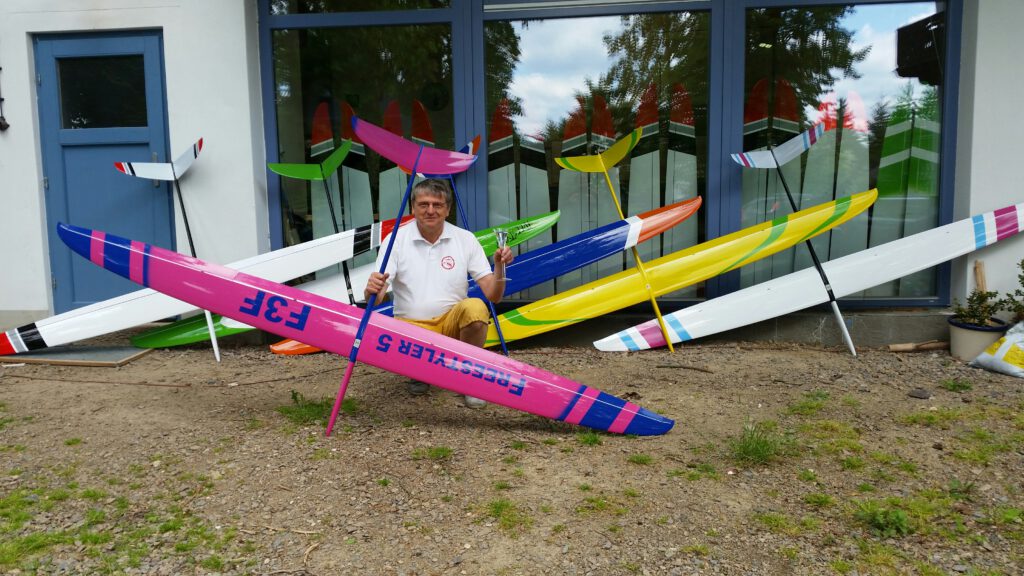
Speed ist nur durch noch mehr Speed zu ersetzen
(Andreas Herrig)
Bessere Materialien, bessere RC-Komponenten, eine bessere Nutzung des aerodynamischen Potenzials der Modelle, bessere Hänge, verbesserte Startmethoden und – wahrlich nicht zuletzt – bessere Piloten. All das hat dazu geführt, dass F3F- und F3B-Modelle ganz allgemein schneller geworden sind bzw. geflogen werden. Auch DS wird von einer zunehmenden Zahl von Piloten praktiziert. Freestyler 5 ist unsere Antwort auf diesen Trend und verbessert die Speedleistung über die bereits sehr schnellen Freestyler 3 und 4 hinaus, weshalb er für die eine sehr gute Erweiterung des Modell-Portfolios sowohl des Profis als auch des ambitionierten Freizeitpiloten ist. Der Freestyler 5 richtet sich an die F3F-Szene. Gegenüber den Freestylern 3 und 4 entwickelt er seine besondere Stärke im Sub-40er-Bereich, die mit zunehmender Geschwindigkeit immer stärker hervortritt. Dies wird nicht nur durch einen geringeren Widerstand im Geradeausflug, sondern durch eine verbesserte Wendeperformance bei diesen hohen Geschwindigkeiten ermöglicht. Weiterhin ermöglicht ein bei den hohen Geschwindigkeiten breitbandigeres Profil-Design ein einfacheres Snap-Flap-Setup, was es auch dem weniger geübten Piloten ermöglicht, ein leistungsfähiges Setup zu generieren. Auch der Freizeitpilot, der nicht an ein 30 s-Fenster zum Höhengewinn gebunden ist, wird an den höheren Top-Speeds beim Ablassen aus der Höhe seine Freude haben.Trotz etwas aggressiverer Flügeltiefen-Verteilung bleibt es durch die angepasste Profilierung der Außenflügel beim FS5 bei einem gutmütigen Abreißverhalten, für das unsere Konstruktionen allgemein bekannt sind. Dabei wurde die Pfeilung zugunsten der Flügel-Torsion bei hohen g-Lasten marginal verringert.Viele Kunden wünschten sich eine Modellgröße zwischen den Freestylern 3 und 4. Mit einer Spannweite von 2,94 m und einer Flügelfläche von 57,74 dm² haben wir diesem Wunsch auch entsprochen. Der wesentlich schlankere Rumpf bringt nicht nur aerodynamische Vorteile, sondern beinhaltet auch einige sehr schöne konstruktive Lösungen. Obwohl er sehr klein im Querschnitt ist, sind keine speziellen Servos nötig. Standard-Micro-Servos der Größe des S3155 passen ebenso wie die kleineren 12 mm Servos. Auch die höheren Exemplare wie Graupner HCM-488 bzw. KST können eingebaut werden, wenn man die untere Gehäusekante anfast, die Ruderhebel nach unten biegt und an der Laminat-Überlappung kleine Kerben im Rumpf vorsieht.Der Rumpf ist für 2 Zellen in 18650-Größe designed. Bei Empfängern die breiter als der GR16 (21 mm) sind und hinter den Akku gesetzt werden müssen, bieten sich die kleineren 18500 Rundzellen an. Auch im Flügel wurden kleine Details zugunsten eines einfacheren Ausbaus geändert – die Servoschächte sind nun 5 mm breiter.Der Freestyler 5 ist nicht unbedingt als Ersatz für die Freestyler 3 und 4 gedacht, sondern eine Ergänzung für das bisherige Haupt-Einsatzgebiet. Denn 3er und 4er können ihre F3B-Gene natürlich nicht verleugnen und sind nach wie vor sehr leistungsfähige Allround-Konstruktionen für die mittleren bis schwachen Verhältnisse. Nicht von ungefähr handelt es sich um die amtierenden“ Weltmeister- und Vizeweltmeistermodelle in F3B. Alle Teile des Freestyler 5 können mit denen der Freestyler 3 und 4 kombiniert werden. So kann man auch verschiedene Rümpfe und Leitwerke nach seinen persönlichen Vorlieben kombinieren. Dies lässt dem Piloten nicht nur die Möglichkeit zum kreativen Ausloten der Möglichkeiten, sondern erlaubt auch eine effektive Weiternutzung bereits vorhandener Teile aus unserer Produktion. Es mag zu erwarten sein, dass man den Freestyler 5 hin und wieder auch im F3B sehen wird. Denn auch da gibt es ja windige Wetterlagen, bei denen sich eine bessere Performance im Schnellflug unter Verzicht auf etwas Maximalauftrieb lohnen kann…